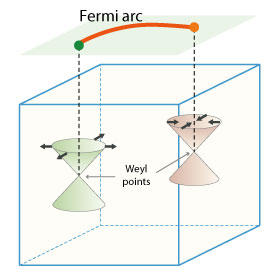

12/26/2016

© 2016 Seigo Souma
An elusive quantum state that can polarize charge carriers for spintronic applications and move them, undisturbed, at ultrahigh speeds has been directly observed by a team at the AIMR1.
First predicted in 1929 but only observed in 2015, Weyl fermions are a special class of quantum particle that have the same spin properties as electrons but are massless like photons. This combination enables electronic charges to be transported at much higher speeds than possible in today’s computing devices. It also allows the quasiparticles to effortlessly move past defects in a crystal structure instead of being scattered by them.
Researchers, however, were unable to spot Weyl fermions until the recent discovery of ‘semimetals’ made from binary transition metals. These materials split electrons into pairs of Weyl fermions at points in the crystal lattice where empty conduction bands cross over into electron-containing valence bands. At these crossover points, Weyl semimetals exhibit properties analogous to a three-dimensional form of graphene but with valuable spin-polarized bands absent in atomic carbon sheets.
Calculations suggest that several types of Weyl semimetals can exist. Now, Seigo Souma from the AIMR at Tohoku University and colleagues in Japan and Germany have made it easier to identify materials with these technologically exciting properties. Souma explains that Weyl fermions always appear with a definite handedness, or chirality. This property is manifested by surface states that have unusual shapes such as those resembling a tadpole or a dog bone. But spotting these ‘Fermi-arc’ states is challenging and time consuming since metals contain many surface states.
“It’s necessary to use band calculations to assign Fermi-arc states from the many observed surface bands,” says Souma. “Without performing these computations, you normally can’t see which is which.”
To detect Fermi-arc states purely by experiment, the AIMR team investigated a niobium–phosphorous material reported to have an ultrahigh charge mobility and large magnetic forces. The team realized that cleaving this metal along specific lattice orientations could produce thin crystal sheets with niobium exposed on one side and phosphorous on the other. By measuring the electronic states of each side with photoemission spectroscopy and contrasting the differences, they mapped the Weyl crossover points and the branch-like Fermi-arc states connecting them (see image).
“No matter how much the surface potential deforms Fermi-arc states, the Weyl points never move,” explains Souma. “These particles are superior to graphene in several ways and can handle large currents because they’re so robust.”
This research highlight has been approved by the authors of the original article and all information and data contained within has been provided by said authors.